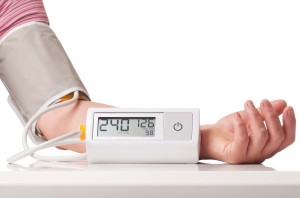One in three adults is suffering from hypertension in America. Hypertension, also known as high blood pressure) is the “second greatest public heath threat” according to the CDC ( Centers for Disease Control and Prevention). Half the people with hypertension have an uncontrolled high blood pressure. This increases the risk of many serious health problems, such as heart attack, stroke, end-stage kidney disease and congestive heart failure. Around 16 million Americans are taking blood pressure medication, but their blood pressure is still not under control. And what makes things worse it that 95 % of the causes are idiopathic, which means the underlying cause is still unknown.
What causes hypertension?

One of the factors contributing to high blood pressure is related to the insulin levels and leptin as a result of processed and high-carbohydrate food diet. Researchers believe that sugars are the primary cause of the rise in insulin and leptin levels. And as the level rises the blood pressure increases. It is known as early as 1998 that people who are insulin resistant also have a high blood pressure, so the link between them is quite significant. By eliminating the excess sugar/fructose from your diet, you attack all issues at the same time.
How is your blood pressure?
The blood pressure readings indicate two numbers. The upper represents the systolic blood pressure reading. As where the lower and second number represent the diastolic pressure.
As an example: 129/70 means 129 systolic arterial pressure and 70 diastolic arterial pressure.
The systolic pressure is the highest pressure in your arteries. It happens at the beginning of the cardiac cycle and represent the contraction of the ventricles. The diastolic refers to a lower arterial pressure, and it occurs during the resting moment of your cardiac cycle. Ideal results should be around 125/70.
| Blood Pressure Classification | Systolic Pressure(mmHg) | Diastolic Pressure(mmHg) |
| Normal | <129 | <70 |
| Pre-hypertension | 129-145 | 70-85 |
| Stage 1 Hypertension | 145-169 | 85-99 |
| Stage 2 Hypertension | ≥169 | ≥100 |
How to avoid a false hypertension diagnosis?
Mistakes happen, and false readings of your blood pressure can vary from day to day. You don’t have to overreact if your blood pressure has once spiked. For example:
If you are overweight. You need to use the right cuff size for your arm. If not, the reading done with a size “average” pressure cuff will show that you have an elevated blood pressure. Which can lead to a false diagnostic. Make sure the doctor is using the right size cuff suitable for your arm.
Incorrect position of the arm. If you are keeping the arm parallel to the body while doing the test, the results will show an 10 percent higher blood pressure than it really is. Keep your arm at a right 90-degree angle from your body.
Nervousness. Fear of doctors can also give a false reading of the blood pressure. This higher reading is associated with stress and fear of the doctor.
Decrease the risk of false readings and being given a false diagnostic for hypertension. Stay calm, breathe normally and relax yourself as your blood pressure is measured.


